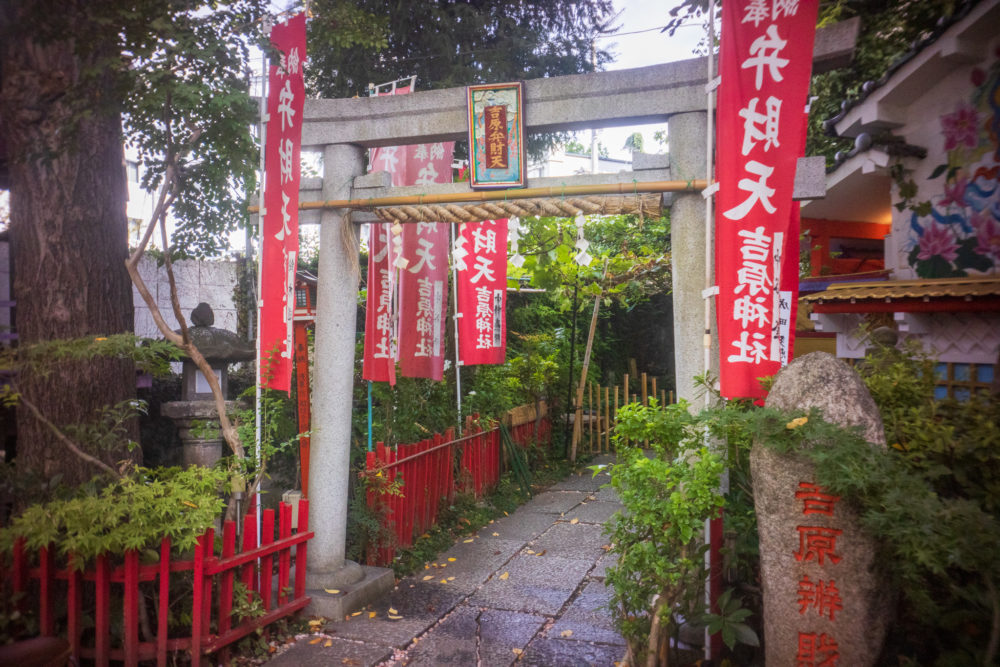Our “Tokyo Shitamachi Tour” category recommends where to visit for sightseeing in Tokyo’s Shitamachi area (the area along and east of the Sumida River). We select a different theme each time and propose a model course of casual self-guided tours.
If you plan to visit Tokyo, the Tokyo Shitamachi Tour is exactly for you. It will help you to find where to go in the Shitamachi area of Tokyo.
We chose Shin-Yoshiwara, which once existed near Asakusa in Tokyo till 1957, for this time. Shin-Yoshiwara was the biggest red-light district in Japan. Shin-Yoshiwara is also known as Yoshiwara Yukaku or just Yoshiwara.
Shin-Yoshiwara wasn’t just a red-light district; it also was a place of social interaction for upper-class people and cultural figures. For this reason, this district was a leading-edge of the culture at the time.
Some of you might already know Shin-Yoshiwara. This district is where the Japanese manga/anime Demon Slayer: Kimetsu no Yaiba takes place in the Entertainment District arc.
The estimated walking time will be about an hour. We will pass through a street where adult entertainment shops are lined up on both sides. So we recommend trying this Tokyo Shitamachi Tour during the daytime.
This blog post will introduce more than ten historical sites related to Shin-Yoshiwara. For your self-guided tour, you can visit all of them, or you can pick some of them. It’s all up to you!
We hope this blog post will help you somewhat when you visit Tokyo for sightseeing. If you have any questions, feel free to contact us through the contact form.
This blog post is also available in Japanese. You can refer to it at the following link:
- Tour Overview
- Tour Details
- A Brief History of Shin-Yoshiwara
- The Route Details
- Minowa Station on the Hibiya Line
- Jokanji Temple
- The Site of Sanyabori Waterway
- The Site of Nihonzutsumi Bank
- Yoshiwara Omon Intersection
- The Site of Yoshiwara Omon Gate
- The Site of Ohagurodobu Moat
- Nakanocho-Dori Street
- Yoshiwara Shrine
- Yoshiwara Benzaiten Shrine
- Mishimaya
- Taito Hospital
- Minowa Station on the Hibiya Line
- Related Blog Posts
Tour Overview
In this Tokyo Shitamachi Tour, we will visit many historical sites related to Shin-Yoshiwara. Shin-Yoshiwara was Japan’s largest red-light district, and it existed near Asakusa in Tokyo until 1957.
We will stop by the following places along the way:
- The throw-away temple
- The sites of the three major brothels
- Yoshiwara Shrine
- Yoshiwara Benzaiten Shrine
- etc.
If you have enough time, it would be fun to visit the following places, as they are both near Yoshiwara Shrine:
- Otori Shrine
- Chokokuji Temple
Recommended For
This self-guided tour is ideal if you are any of the following:
- I want to go beyond the typical tourist attractions.
- I want to visit historical sites in Japan.
- I want to make a pilgrimage to the mange Demon Slayer: Kimetsu no Yaiba.
- etc.
Duration
- Duration: Appoximately 1 hour
Departure & Return
- Departure point: #3 Exit of Minowa Station on the Hibiya Line
- Return point: #3 Exit of Minowa Station on the Hibiya Line
Itinerary
- Minowa Station on the Hibiya Line
- Jokanji Temple
- The site of Sanyabori Waterway
- The site of Nihonzutsumi Bank
- Mikaeri Yanagi (the Willow of Looking Back)
- Emonzaka Hill
- Gojikken-Michi Street
- The site of Yoshiwara Omon Gate
- The site of Ohagurodobu Moat
- Kasutori Bookstore
- The site of Daimonji-Ro Brothel
- Nakanocho-Dori Street
- The site of Inamoto-Ro Brothel
- The site of Kadoebi-Ro Brothel
- Suidojiri Street
- Yoshiwara Shrine
- Yoshiwara Benzaiten Shrine
- Taito Hospital
- Minowa Station on the Hibiya Line
Restrooms
- Minowa Station on the Hibiya Line
- Yoshiwara Park
- FamilyMart on Nakanocho-Dori Street
- Taito Hospital
- Hanazono Park
- Mishimaya
Tour Details
A Brief History of Shin-Yoshiwara

Honestly, the historical sites related to Shin-Yoshiwara are not fancy or gorgeous like Sensoji Temple. You should know a bit about Shin-Yoshiwara beforehand to fully enjoy this tour.
The history of Shin-Yoshiwara dates back to the 17th century.
In 1617, the Tokugawa Shogunate licensed a Yukaku in Nihonbashi. A Yukaku is a segregated red-light district surrounded by walls or moats. And this yukaku was called Yoshiwara Yukaku.
There were two core reasons why the Tokugawa Shogunate created Yoshiwara Yukaku:
- By consolidating brothels into one place, the government wanted to protect public morals and safety in the city of Edo (Tokyo at present);
- By making the landlord manage the Yukaku, the government could collect taxes efficiently.
In 1656, the Tokugawa shogunate planned to relocate Yoshiwara Yukaku to another place. In 1657, Yoshiwara Yukaku moved from Nihonbashi to Nihonzutsumi near Asakusa.
The reasons why the Tokugawa Shogunate relocated Yoshiwara Yukaku were the followings:
- Nihonbashi had become the center area as the city of Edo developed;
- The Great Fire of Meireki in 1657 burned down most of the city of Edo.
Yoshiwara Yukaku in Nihonbashi was called Moto-Yoshiwara (the former Yoshiwara), and one in Nihonzutsumi was called Shin-Yoshiwara (the new Yoshiwara.)
Including unofficial ones, there were many red-light districts in Japan. And Shin-Yoshiwara was the largest among them. At one time, more than 8,000 people were working in Shin-Yoshiwara.
Shin-Yoshiwara wasn’t just a red-light district; it also was a place of social interaction for upper-class people and cultural figures. For this reason, this district was a leading-edge of the culture at the time.
Many Yujo (courtesans) of Shin-Yoshiwara were highly educated and had high self-esteem. Customers also had to be well-educated and mind their manners.
In 1957, the Showa Government issued the Anti-Prostitution Law. With this, Yoshiwara Yukaku ended its 340-year history.
The Route Details
Minowa Station on the Hibiya Line
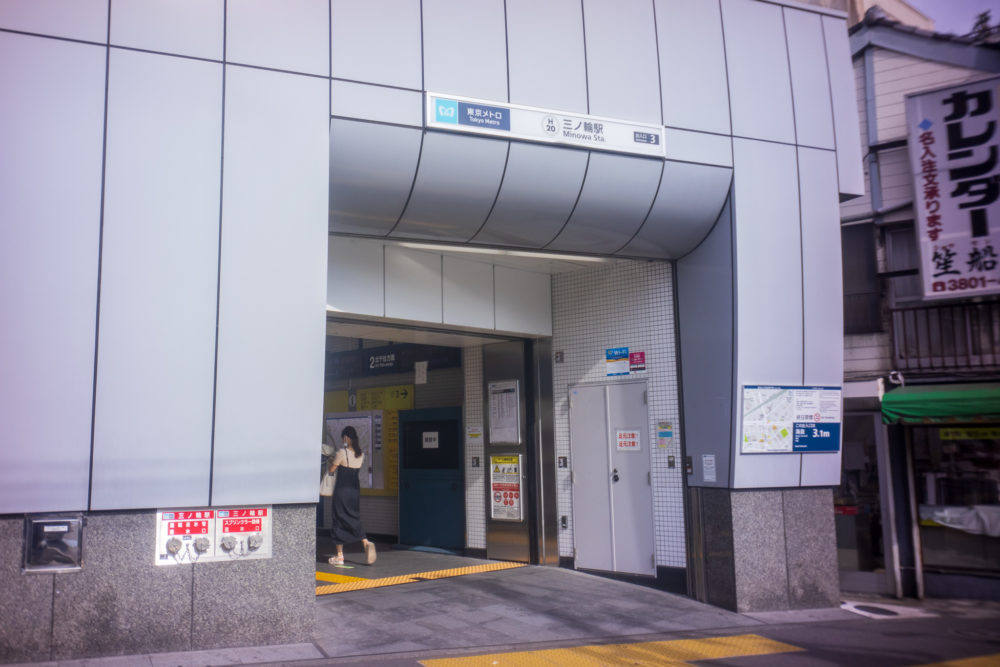
Our tour starts at Exit #3 of Minowa Station on the Hibiya Line. To take this exit, take the stairway toward Kitasenju at the platform of Minowa Station.
When you get to the ground level, you will see a big intersection of Meiji-Dori Avenue and Showa-Dori Avenue on your right. Walk toward the intersection.
Turn right at the intersection and walk along Showa-Dori Avenue. You will see an orange sign of Matsuya, a beef bowl restaurant.
After passing the Matsuya restaurant, turn right on the first alley. You will find Jokanji Temple, our next stop point, on your left.
Jokanji Temple
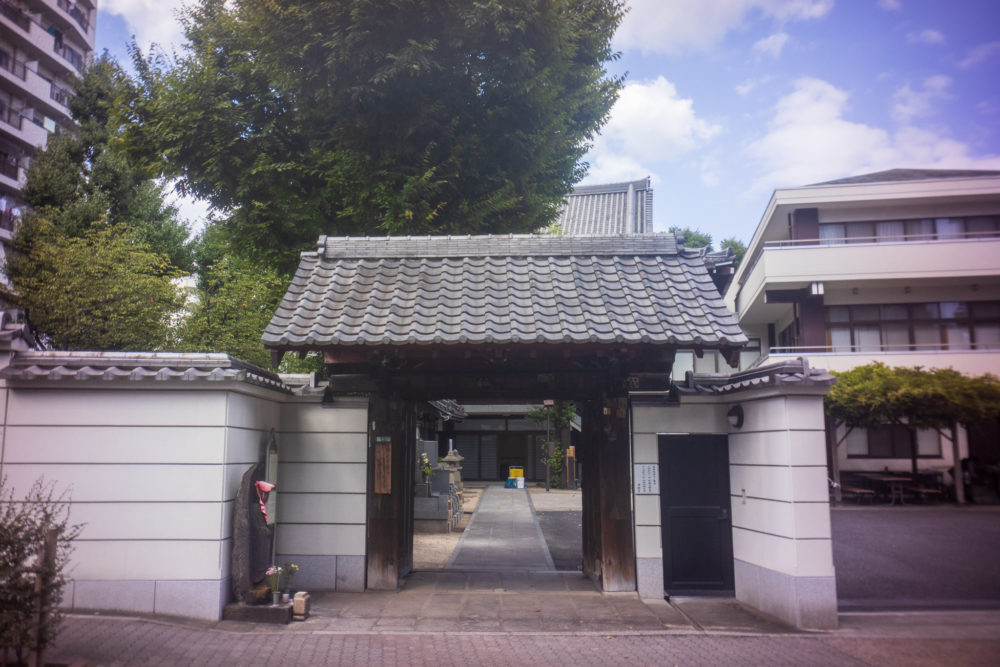
Jokanji Temple is a Buddhist temple built in 1655. This temple is about 10 to 15 minutes away on foot from Shin-Yoshiwara.
Another name for Jokanji Temple is Nagekomi-Dera, a throw-away temple. When a courtesan died in Shin-Yoshiwara, her body was thrown into this temple without dignity or respect.
In the Asakusa area, there were several throw-away temples of Shin-Yoshiwara, such as Sho’okuin Temple and Daionji Temple. But Jokanji Temple was the most well-known.
As a throw-in temple of Shin-Yoshiwara, Jokanji Temple has many historic sites related to Shin-Yoshiwara.
Shin-Yoshiwara Soreito (The Memorial Tower for the Yujo)
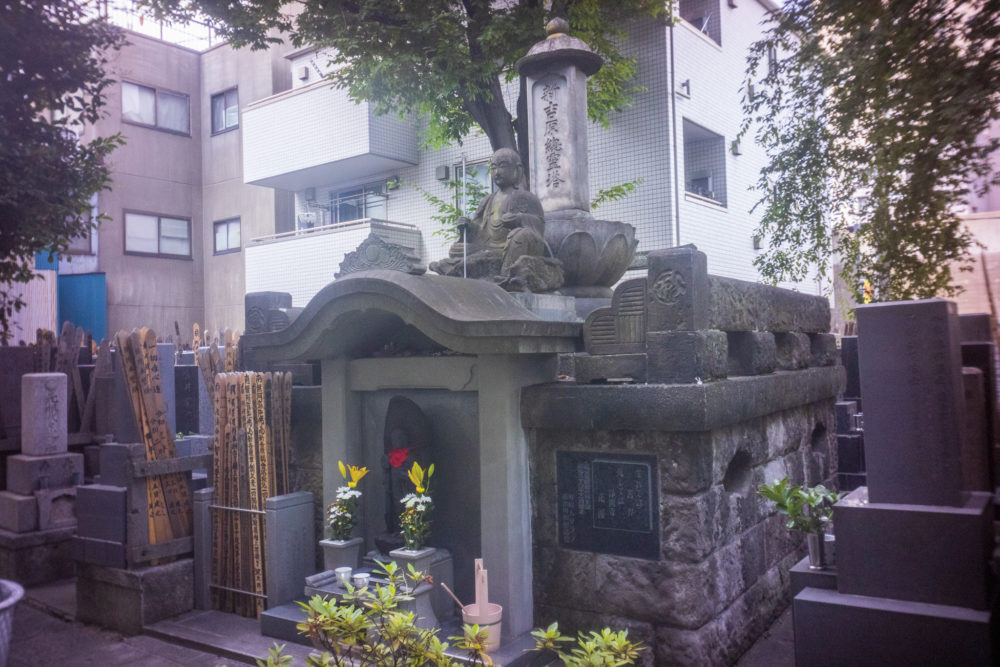
Jokanji Temple has many historical sites related to Shin-Yoshiwara. Shin-Yoshiwara Soreito, the Memorial Tower of Shin-Yoshiwara, is one of them.
In 1855, a big earthquake named the Ansei Edo Earthquake attacked the city of Edo. It killed more than 500 women in Shin-Yoshiwara. Jokanji Temple built Shin-Yoshiwara Soreito for them.
Today, this memorial tower is dedicated to those related to Shin-Yoshiwara. According to the temple, they pray for more than 25,000 people.
Hanamata Kasui’s Senryu Poem

You can find a senryu, a Japanese form of poetry, on the wall of Shin-Yoshiwara Soreito. This poem is by Hanamata Kasui, a senryu poet from the late 19th century to the early 20th century.
This senryu poem says, “Born in hell, buried in Jokanji Temple.” It expresses how hard the women’s lives at Shin-Yoshiwara were. They had extremely difficult lives. They had no dignity or respect, even when they died.
Wakamurasaki’s Grave

You can find the grave of Wakamurasaki near the inner gate. Wakamurasaki was an Oiran, the high-ranked Yujo at Shin-Yoshiwara, in the late 19th century, according to the temple.
Wakamurasaki was a very beautiful, well-educated, and affectionate woman. Therefore, she got her name from “The Tale of Genji,” Japanese literature written in the 11th century.
As she was so popular, she was able to complete the contract as Yujo in five years, which was the shortest period for Yujo.
She was going to marry her longtime lover after leaving Shin-Yoshiwara, but she couldn’t. A random killer attached her five days before she left Shin-Yoshiwara.
It was five days before Wakamurasaki left Shin-Yoshiwara. A random killer attacked her; she passed away at the age of 22. People felt soeey for Wakamurasaki and built her grave at Jokanji Temple.
The Site of Sanyabori Waterway
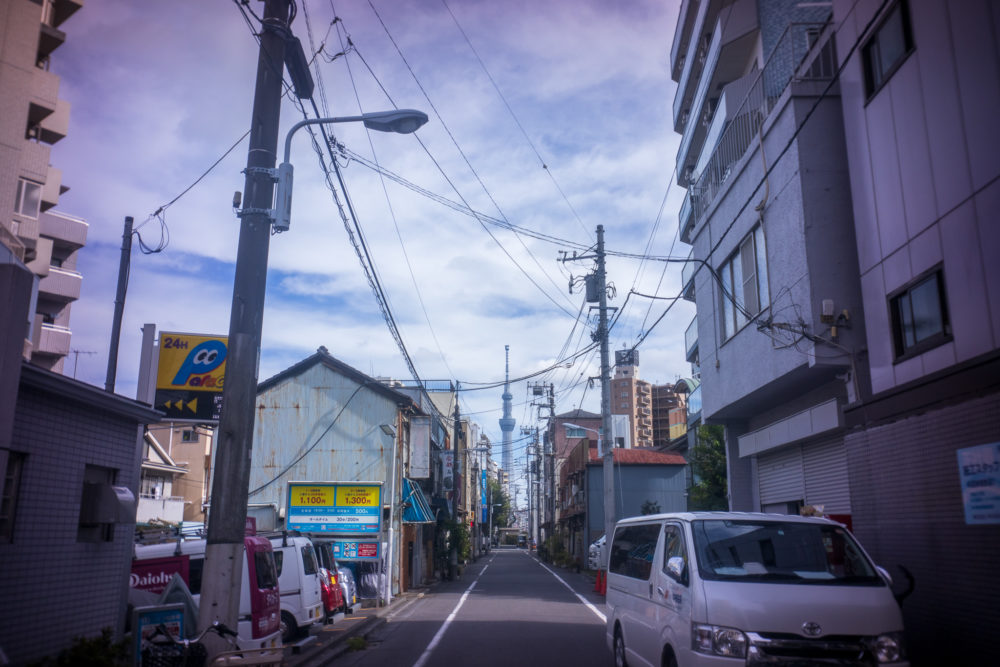
There is a public toilet near Jokanji Temple. From the street in front of the toilet, you can see the Tokyo Skytree in front. I like taking pictures of Tokyo Skytree with Shitamachi buildings.
In the past, there was a waterway named Sanyabori around this street. It ran from here to the Sumida River near Asakusa. During the Edo period, people traveled by boat from the Sumida River to Shin-Yoshiwara through Sanyabori Waterway.
The Site of Nihonzutsumi Bank
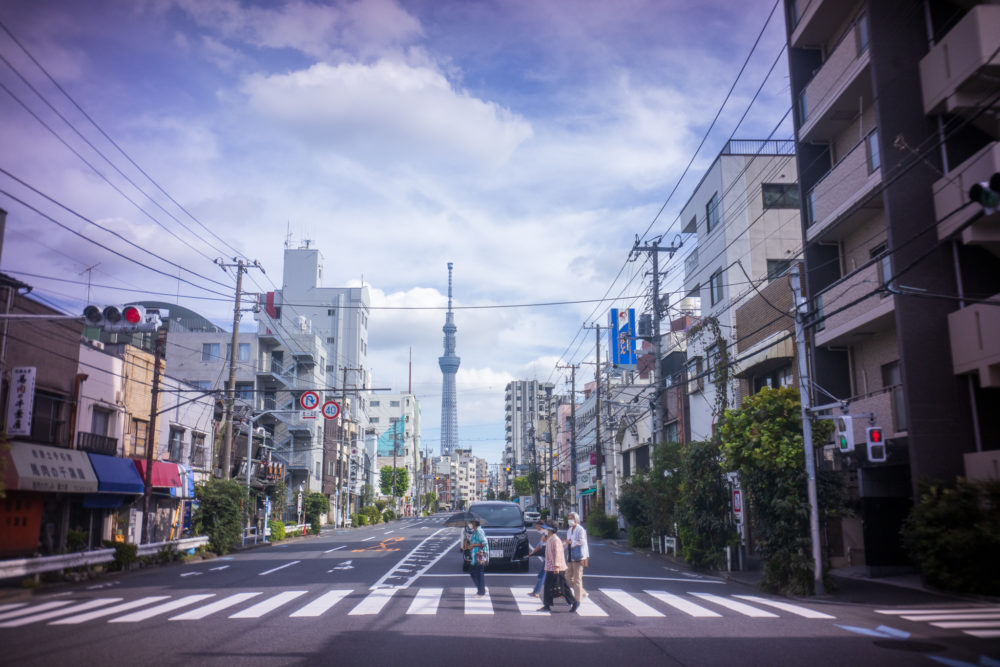
Return to Exit #3 of Minowa Station, the starting point of this tour. You will see Meiji-Dori Avenue in front of the station exit. Meiji-Dori Avenue splits into Dote-Dori Avenue on the way. We walk along these two avenurs towards Tokyo Skytree.
There once was an enbankment named Nihonzutsumi from Minowa to the Sumida River through Dote-Dori Avenue. Nihonzutsumi was along the south side of Sanyabori Waterway.
Yoshiwara Omon Intersection

After walking about ten minutes from Minowa Station along Dote-Dori Avenue, you will get to Yoshiwara Omon Intersection. The landmark of this intersection is a guide board of Taito Hospital.
Turn to the right at this intersection, the entrance of Shin-Yoshiwara is almost there.
Mikaeri Yanagi (The Willow of Looking Back)
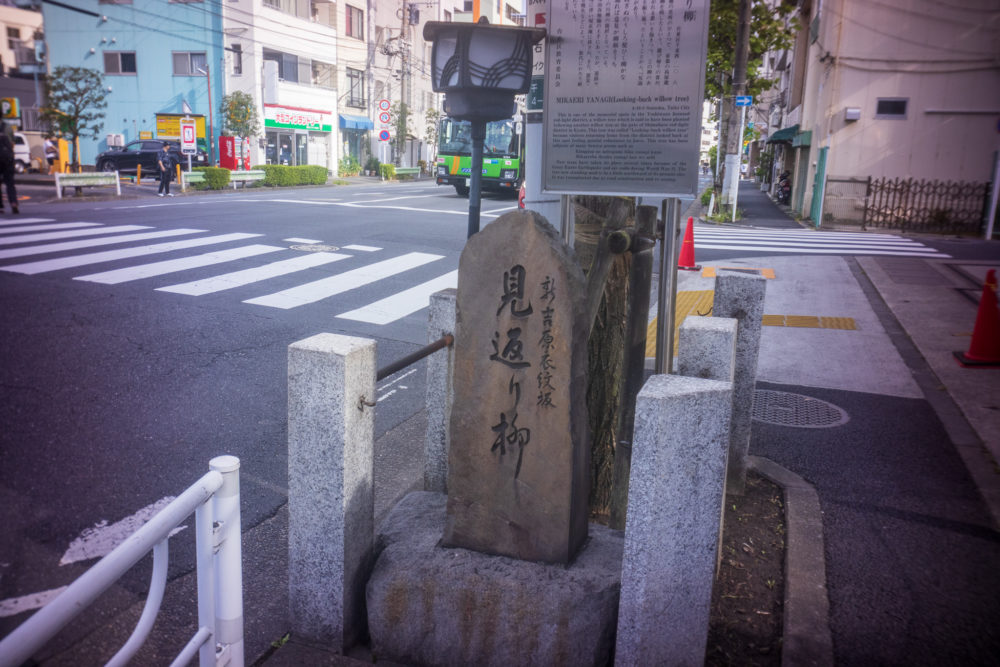
In front of the gas station at Yoshiwara Omon Intersection, you can find a willow tree and its stone monument. People in old days called this willow tree Mikaeri Yanagi, which is “the willow of looking back” in English.
After leaving Shin-Yoshiwara, male guests turned around at this willow tree and recalled their good memory at the Yukaku.
Emonzaka Hill
From the top of Nihonzutsumi bank towards the Yukaku, there once was a sloping path called Emonzaka. Emon is an old word meaning to adjust your clothes, and Zaka means a hill or a sloping path in this case.
Before visiting the Yukaku, male guests adjusted their clothes on this sloping path. This was how they tried to give a better impression to the Yujo at Shin-Yoshiwara.
Gojikken-Michi Street

Gojikkenmichi is the street between Emonzaka Hill and the main gate of Shin-Yoshiwara.
Gojikken is a length in an old unit of length in Japan, it is about 90 meters. And Michi means a street. It was about 90 meters from Emonzaka Hill to the main gate of Shin-Yoshiwara.
Gojikkenmichi is an S-shaped street. This is to make the inside of the Yukaku invisible from the outside.
In the middle of Gojikkenmichi Street, there was a small Shinto shrine named Yoshitoku Inari Shrine. There once were five small Shinto shrines to guard Shin-Yoshiwara. And Yoshitoku Inari Shrine was one of them.
The Site of Yoshiwara Omon Gate
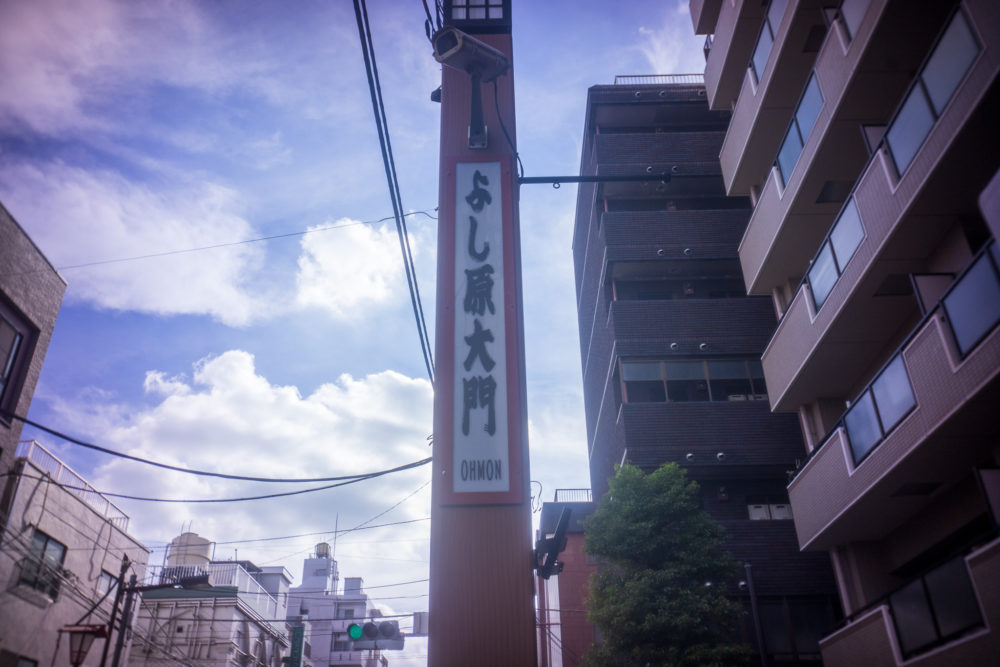
Yoshiwara Omon Gate was the only entrance to Shin-Yoshiwara at normal times. Even if it says “gate,” there was no door to close this gate. For this reason, “Demon Slayer: Kimetsu no Yaiba” features Yoshiwara Omon as an arched entrance.
The Site of Ohagurodobu Moat

There is a police box near Yoshiwara Omon Gate. The street next to the police box used to be a part of Ohagurodobu Moat.
Ohagurodobu Moat surrounded the premises of Shin-Yoshiwara. The width of the moat was initially about 9m. This moat was to prevent the Yujo in Shin-Yoshiwara from escaping.
The Stone Wall of Ohagurodobu Moat
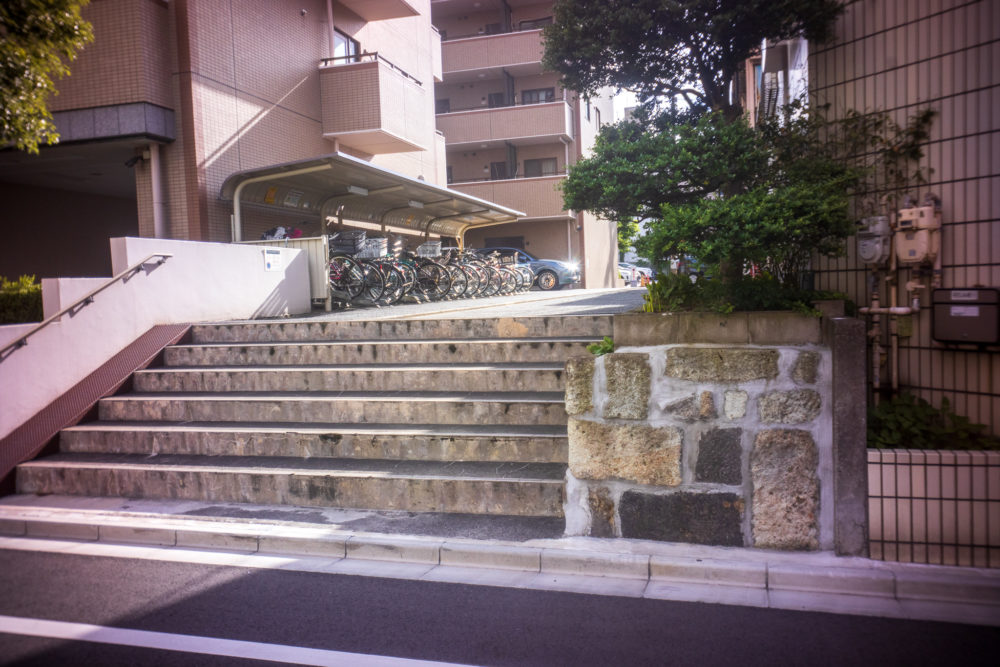
Ohagurodobu Moat was fulled in by the early 19th century. And only few remains left about the moat.
There is a condominium behind the police box. You can find a stone wall next to the condominium. This is the remains of Ohagurodobu Moat.
Kasutori Bookstore
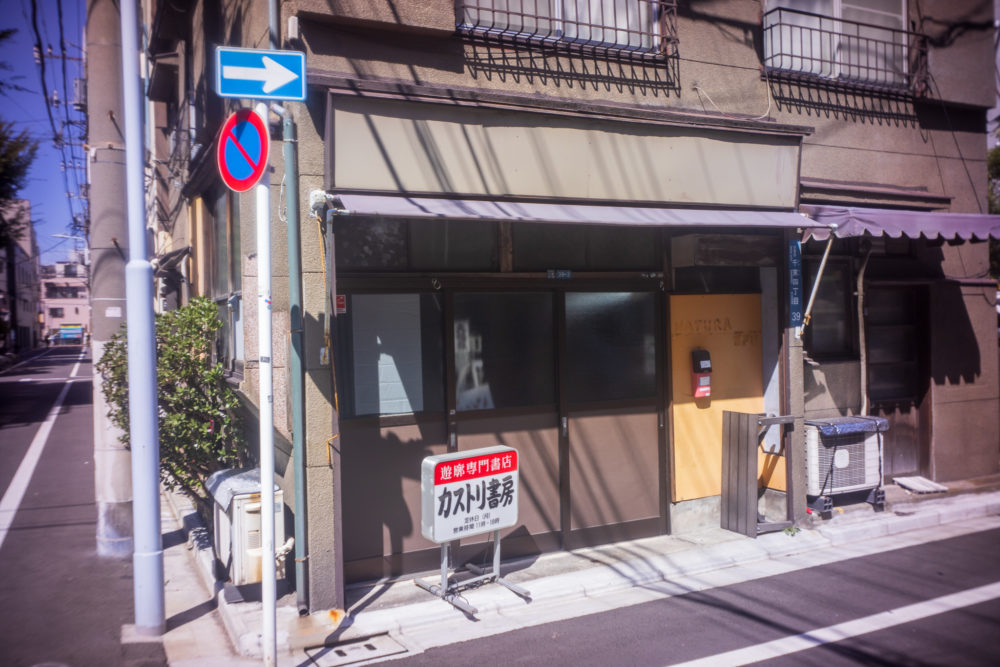
Near the remains of Ohagurodobu Moat, there is a bookstore named Kasutori Bookstore. This bookstore specializes in books and other resources related to the Yukaku.
According to Wikipedia, Kasutori came from Kasutorishu, an old Japanese word meaning low-quality bootleg liquor. Kasutorishu was very popular and sold everywhere in Japan after World War II.
The site of Daimonji-Ro Brothel
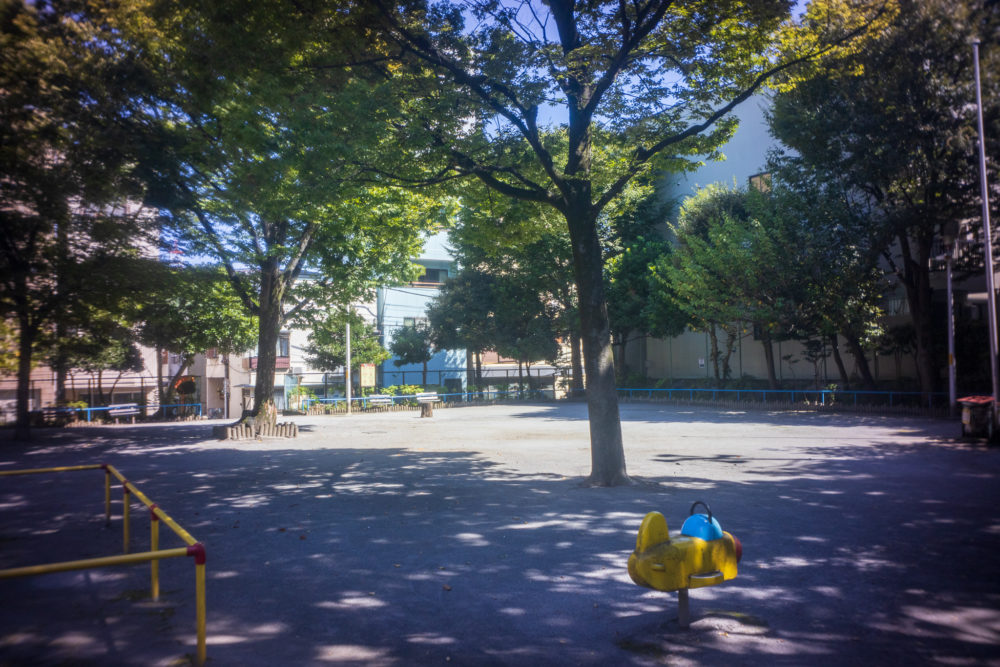
Yoshiwara Park is a short walk from Kastori Bookstore. This park is the site of Daimonji-Ro Brothel, one of the three major brothels in Shin-Yoshiwara in the late 19th century.
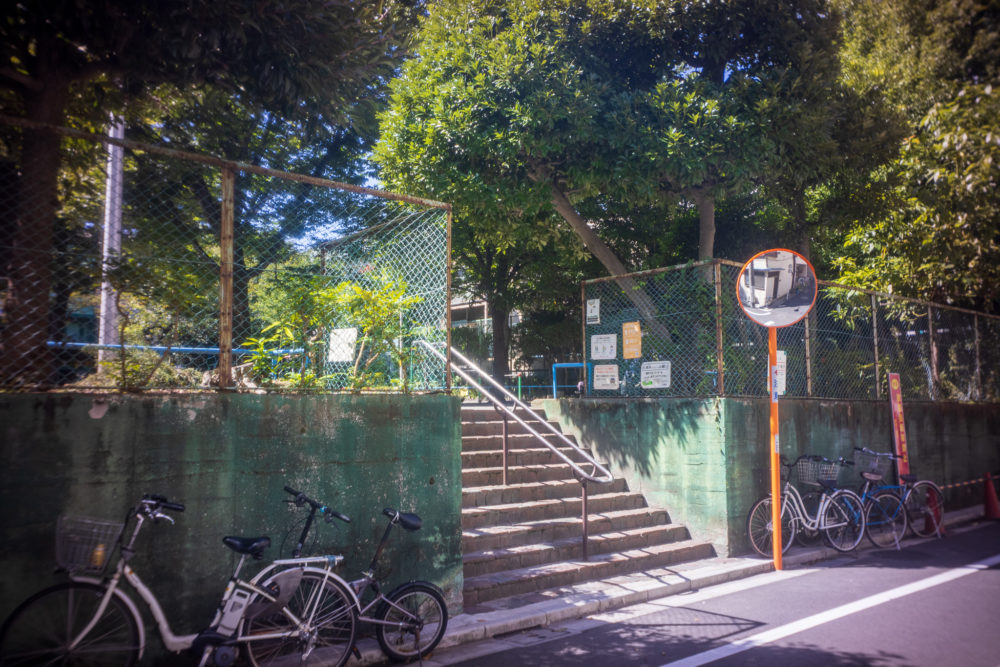
As you can see, Yoshiwara Park is located on a higher level than the street. Shin-Yoshiwara could have been at this height when you view it from the moat.
The Site of Enomoto Inari Shrine

In the sandbox at the west end of Yoshiwara Park, there was a small Shinto shrine named Enomoto Inari Shrine. There once were five small Shinto shrines to guard Shin-Yoshiwara. And Enomoto Inari Shrine was one of them.
Nakanocho-Dori Street
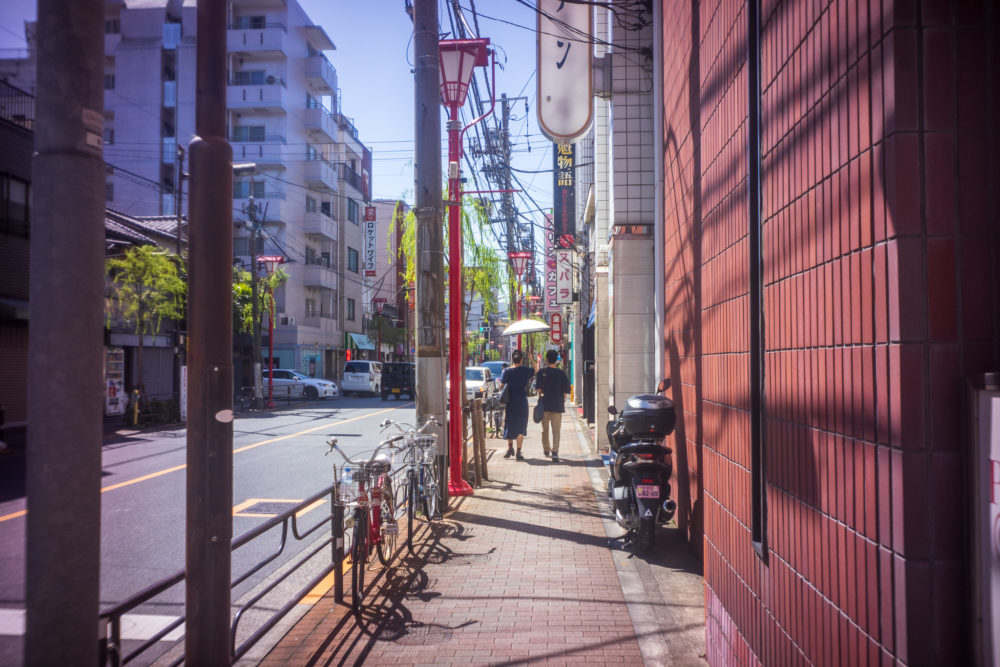
Return to Yoshiwara Omon Gate from Yoshiwara Park, then continue straight ahead. This street is Nakanocho-Dori Street.
Nakanocho-Dori Street was the main street of Shin-Yoshiwara. Today, there are adult entertainment shops lined up on both sides of the street. Some people may feel uncomfortable walking this street.
Surprisingly, Nakanocho-Dori Street is also a school route. I have mixed feelings when I see elementary school students walking this street to go home.
The Site of Inamoto-Ro Brothel

When you go further along Nakanocho-Dori Street, you will get to Senzoku 4-Chome Intersection. If you turn left at this intersection, you will find Hotel Inamoto.
At the premises of Hotel Inamoto, there was a brothel named Inamoto-Ro during the Shin-Yoshiwara era. Inamoto-Ro Brothel also was one of the three major brothels in Shin-Yoshiwara in the late 19th century.
The Site of Kadoebi-Ro Brothel
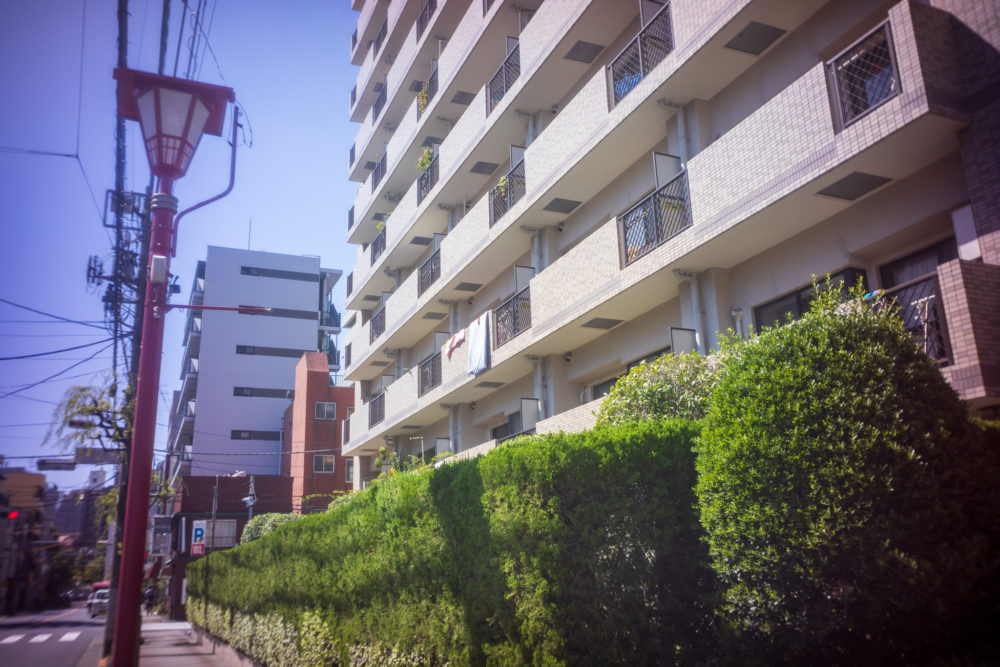
Near the intersection where Nakanocho-Dori Street meets Kyomachi Street, you will find a condominium. At the premises of the condominium, there was Kadoebi-Ro Brothel.
Kadoebi-Ro Brothel was one of the three major brothels in Shin-Yoshiwara in the late 19th century. And Wakamurasaki, who is buried in Jokanji Temple, worked here.
Kadoebi-Ro Brothel was famous for its clock tower. HIGUCHI Ichiyo, a female writer in the late 19th century, featured this clock tower in her novel Takekurabe.
Suidojiri Street
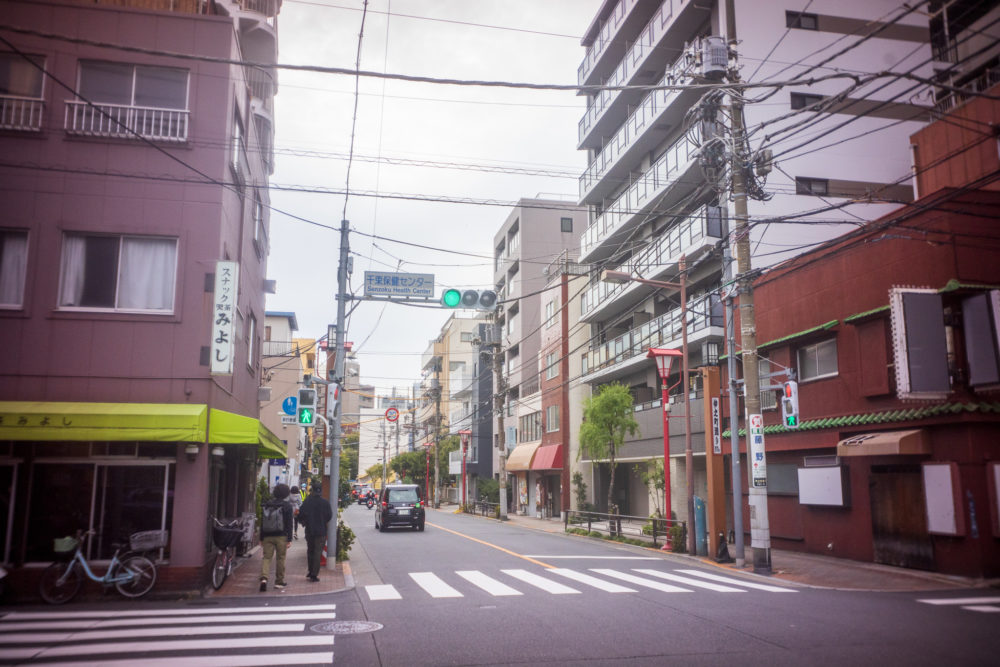
After going further along Nakanocho-Dori Street, you will get to Suidojiri. Suidojiri was the innermost part of Shin-Yoshiwara.
There was a back gate of Shin-Yoshiwara was at Suidojiri. And this gate was closed at normal times so that no one could get out from here.
Chokokuji Temple and Otori Shrine near this back gate had the Tori-No-Ichi Festival in November annually. The back gate was open during this festival. Many people visited Shin-Yoshiwara after enjoying this festival.
Also, in front of the back gate atSuidojiri, there was the Akiba Joyato Nightlight. This nightlight enshrined Akiba Gongen, the god of fire suppression.
The Site of Ohagurodobu Moat

On the way from Suidojiri to Yoshiwara Shrine, Nakanocho-Dori Street intersects with a narrow alley. If I understand correctly, this alley also was a part of Ohagurodobu Moat.
Yoshiwara Shrine
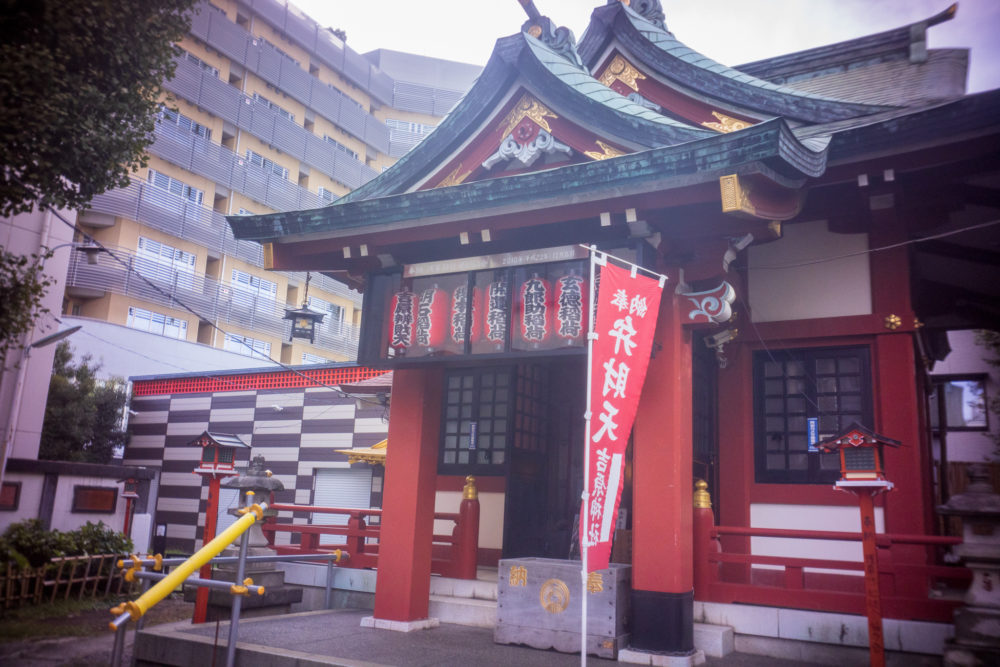
After passing Suidojiri, you will get to Yoshiwara Shrine on your right.
As mentioned above, there were five small Shinto Shrines in and around Shin-Yoshiwara as guardian gods. Yoshiwara Shrine enshrines these five gods in one place.
Women working at Shin-Yoshiwara had deep faith in Yoshiwara Shrine. Even now, this shrine is famous that granting women’s wishes.
For more information about Yoshiwara Shrine, please refer to the following article.
Aizome Sakura (The Sakura of Meeting a Lover)
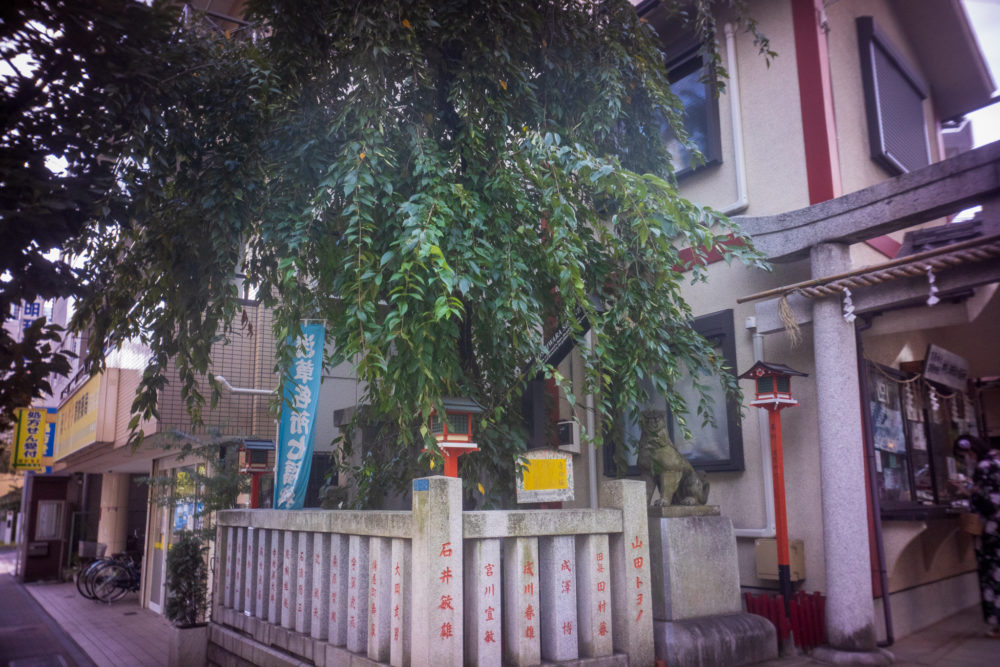
On the left side of the entrance of Yoshiwara Shrine, you will find a Sakura (cherry) tree planted. This cherry tree is known as Aizome Sakura. Aizome means meeting someone you are deeply in love with.
Aizome Sakura was originally planted near Emonzaka. According to the shrine, male guests entered Shin-Yoshiwara after praying for a wonderful encounter.

After passing Yoshiwara Shrine, Nakanocho-Dori Street became an S-shaped street. Like Gojikkenmichi Street, this is to make the inside of the Yukaku invisible from the outside of the back gate.
Yoshiwara Benzaiten Shrine

If you go further along Nakanocho Street, you will get to Yoshiwara Benzaiten Shrine. Even this is located away from Yoshiwara Shrine, but Yoshiwara Shrine manages this shrine.
There was a pond named Benten-Ike (AKA. Hanazono-Ike) around here till 1959. Benten is another name of Benzaiten, a goddess of financial fortune and artistic talent. And Ike means a pond in English.
There was a small shrine that enshrines Benzaiten by the pond. People working in Shin-Yoshiwara had faith in this Benzaiten.
The Statue of Yoshiwara Kannon

In the precincts of Yoshiwara Benzaiten, you will find the Statue of Yoshiwara Kannon. This statue is dedicated to the victims of the Great Kanto Earthquake in 1923.
In 1923, the Great Kanto Earthquake attacked Tokyo. This earthquake caused fires in many areas including Shin-Yoshiwara and its surrounding areas.
As many Yujo had nowhere to escape inside Shin-Yoshiwara, they jumped into Benten-Ike Pond to avoid the fire. As a result, 490 women ended their life.
Other Historical Sites
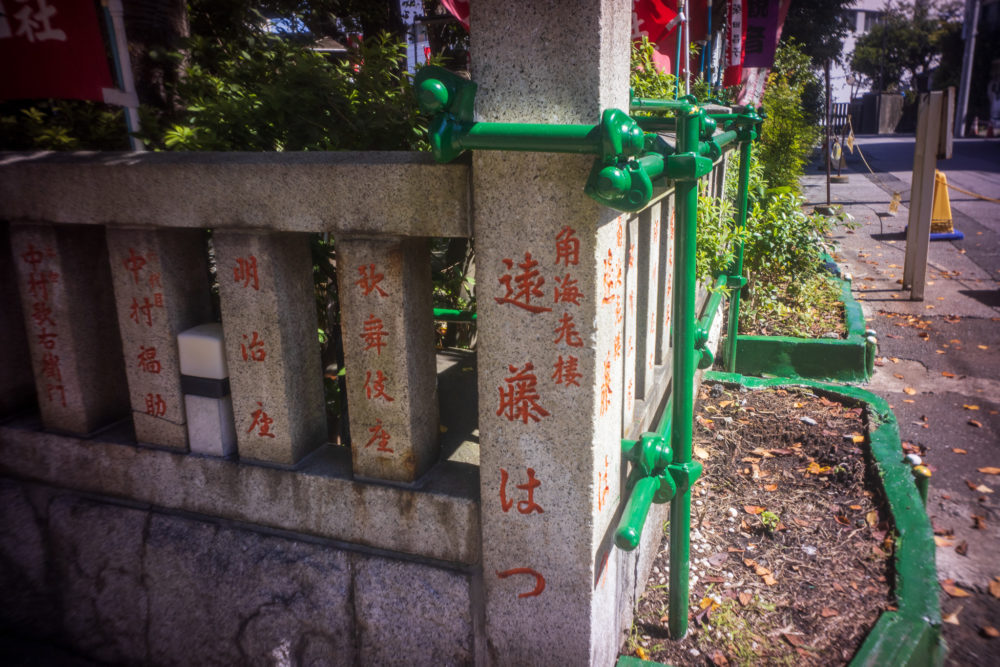
Yoshiwara Benzaiten Shrine retains remnants of Shin-Yoshiwara here and there. For example, you can find the names of brothels, such as Kadoebi-Ro Brothel, on the stone fence that surrounds the shrine.
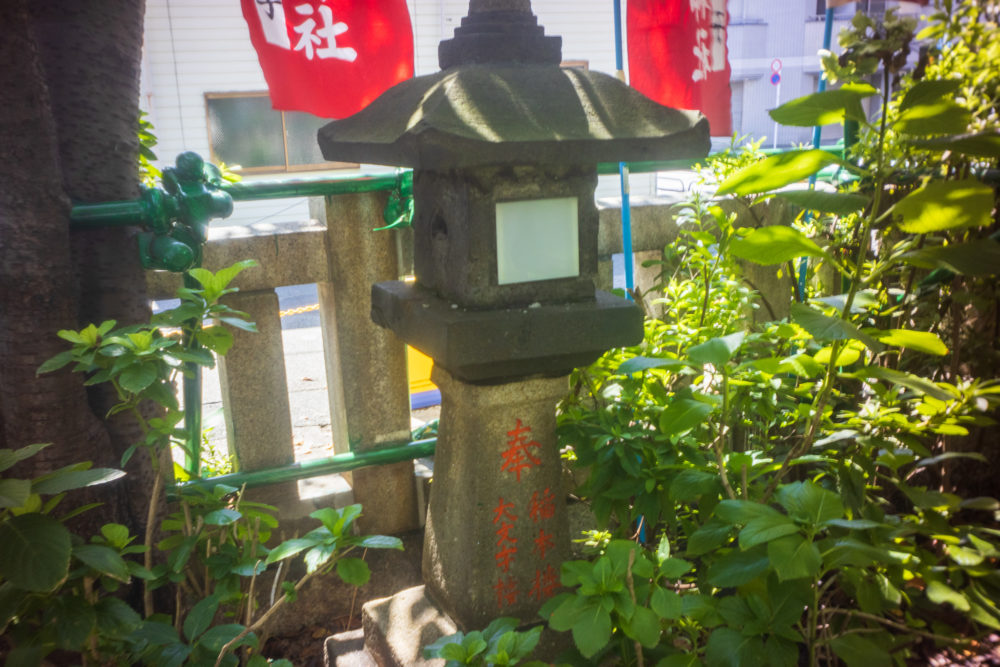
You also can find stone monuments, which brothels dedicated, in the precincts of Yoshiwara Benzaiten Shrine. You can recognize the name of Daimonji-Ro Brothel and Inamoto-Ro Brothel in the photo above.
Mishimaya
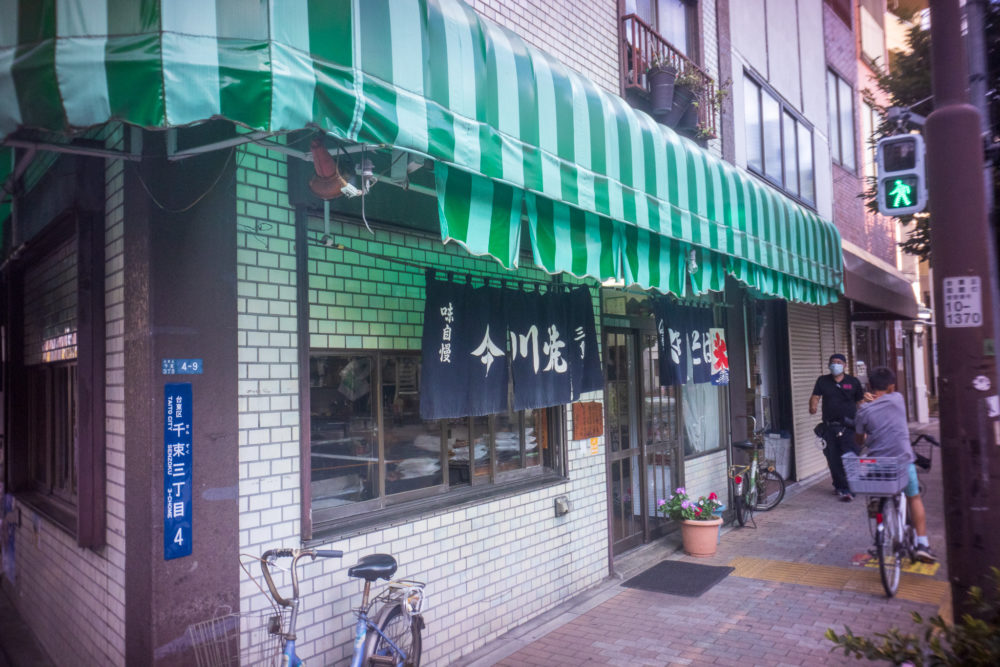
Mishimaya is a mom-and-pop restaurant that specializes in Japanese sweets and light meals, such as Okonomiyaki. Whenever I visit this restaurant, I feel as if I were back in the 20th century.
My favorite meals here are Yakisoba and Imagawayaki. Yakisoba is a fried noodle, and Mishimaya uses thick and chewy noodles. Imagawayaki is a thick pancake containing bean jam. Mishimaya’s Imagawayaki is very soft even when it gets cold.
When you would like to drink juice or beer here, you will have to take a can out from the refrigerator in the restaurant by yourself. This is the generosity of the Shitamachi area of Tokyo.
Taito Hospital
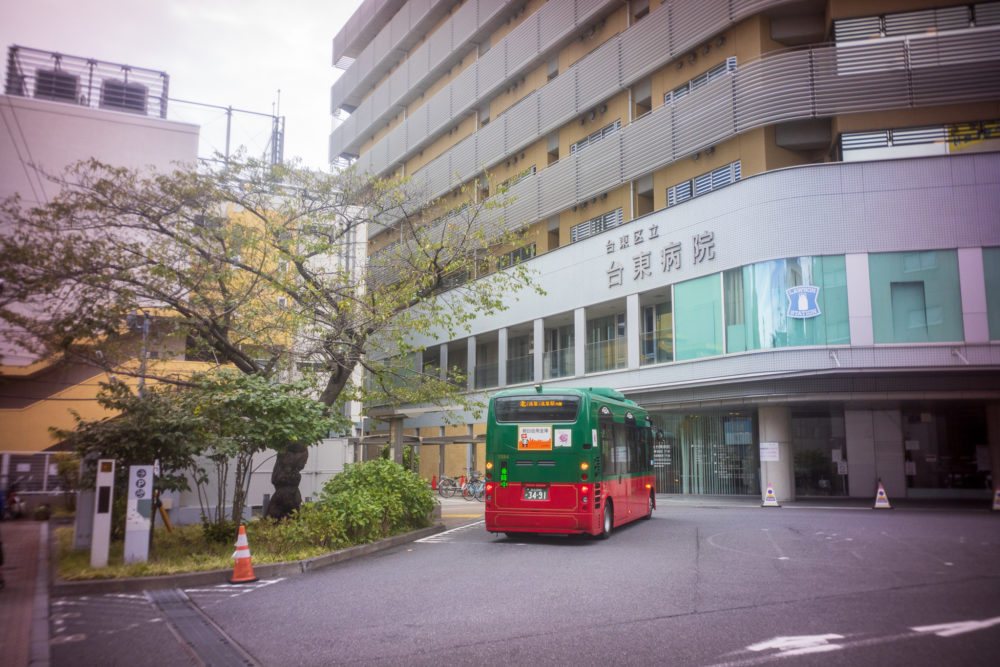
Taito Hospital is located along Nakanocho-Dori Street. More specifically, it’s around the middle of Yoshiwara Benzaiten Shrine and Yoshiwara Shrine.
On the premises of Taito Hospital, there is a bus stop for Megurin Bus. Megurin Bus is a community bus service operated by Taito Ward. And the fee is only 100 Yen per ride.
Take the North Route (Negishi) of Megurin Bus here. This bus will bring you back to Minowa Station via Yoshiwara Omon Intersection. Therefore, it is perfect for reviewing this Tokyo Shitamachi Tour.
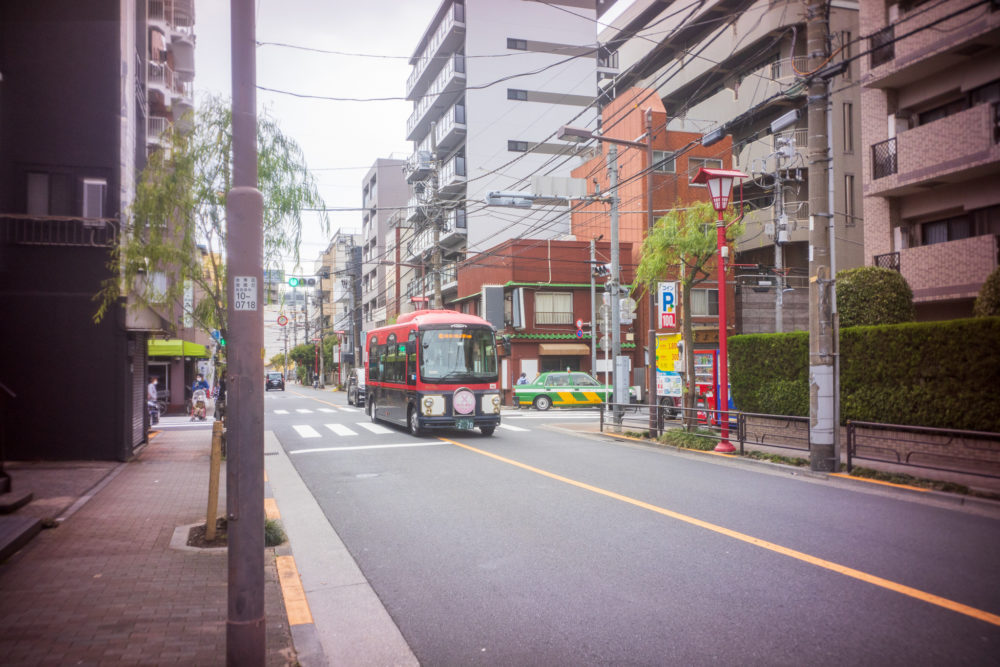
If you want to go to Asakusa from Taito Hospital, take the North Route (Asakusa) of Megurin Bus. If you want to go to Ueno, take the South Route of Megurin Bus here.
For more information about the Megurin Bus, please refer to the following article.
Minowa Station on the Hibiya Line
Take down the bus at Minowa Station (Bus stop #5.) Well, done!
